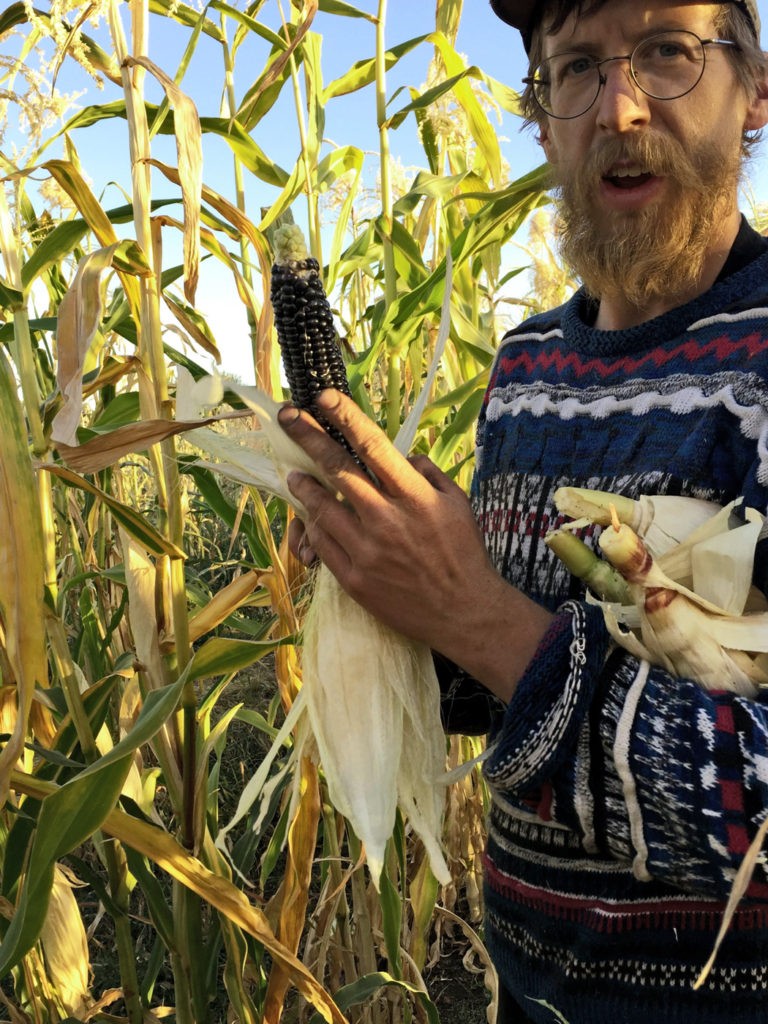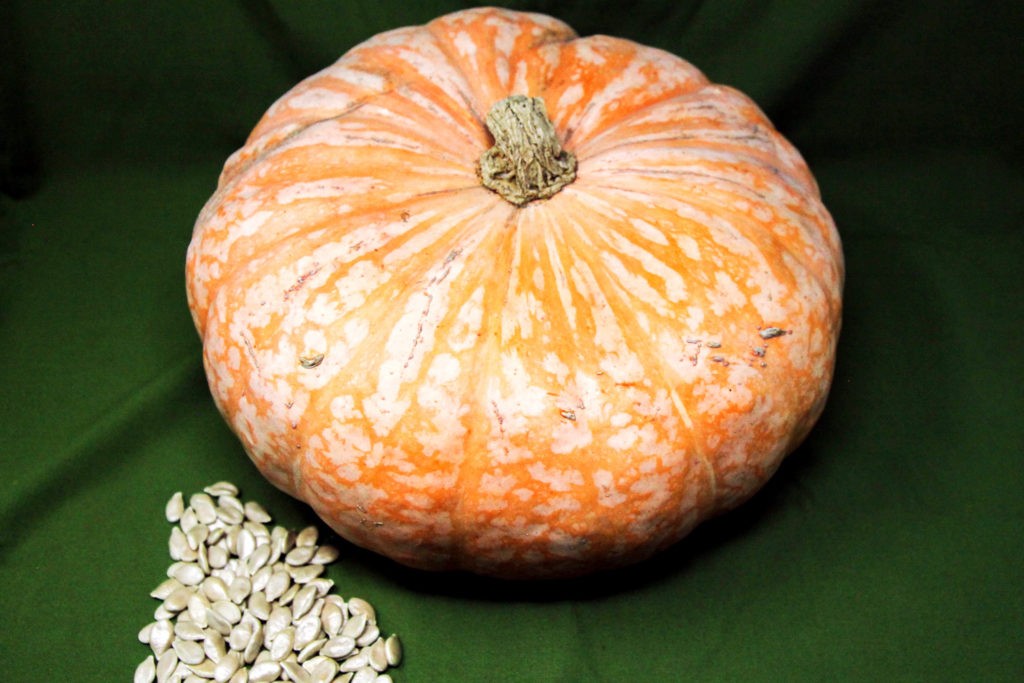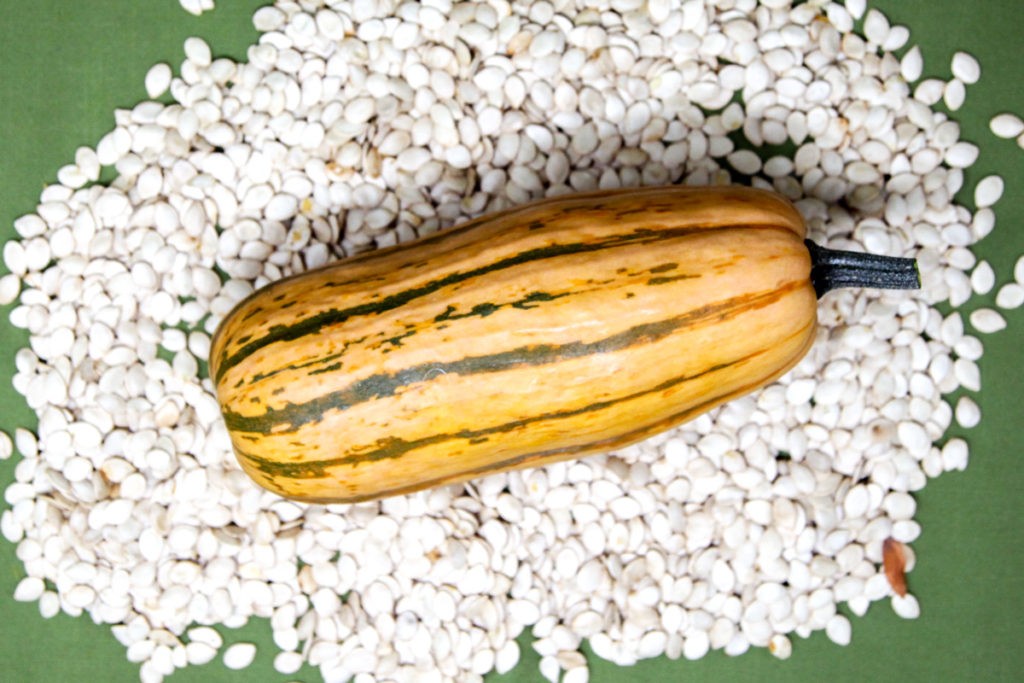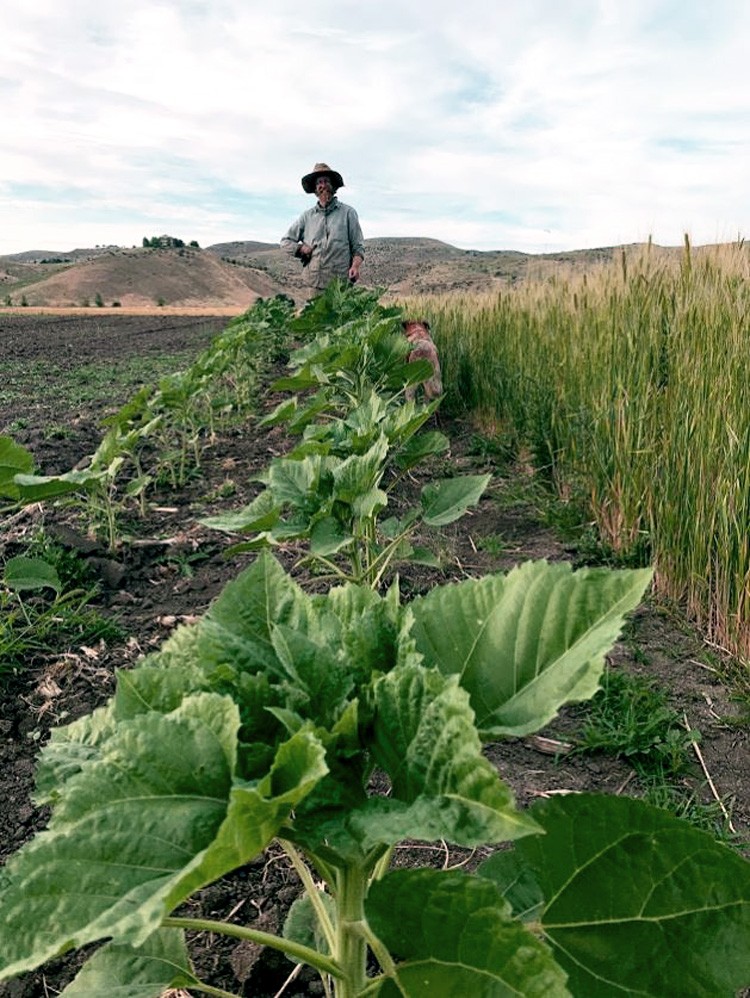Brennan Henry Allsworth is a grain, vegetable, herb, flower, and seed farmer who lives near Boise. I met him in the comments thread of the organic gardening subreddit, after I had shared my recent seed company profiles there. When Brennan Henry described himself as a “seed head” and said that yes, he does grow squash seed, I asked him to be my first interviewee. He graciously agreed. Brennan Henry even introduced me to some squashes on our video call.
You can buy a selection of seed grown on Brennan Henry’s Winnower Farm here.
In the long term, I aim to profile all sorts of “squashpersons” on the site, which may include farmers, gardeners, breeders, packers/marketers, chefs, cooks . . . anyone with a strong relationship with my favorite cucurbits! If you’ve got a squashperson to recommend, please introduce me.

Squashperson Interview: Brennan Henry Allsworth, Seed Farmer
January 2021
Tell me about your farm?
I run Winnower Farm which is in its third year of production. I’ve been working on organic farms for probably seven full-on seasons now. All this started when I began WWOOFing near Asheville. Right after high school a friend of mine offered for me to go with him for the summer. I’ve been hooked ever since.
I live in Boise Idaho now. That’s where Winnower Farm is. I farm on the grounds of the Shoshone / Bannock people. We’re part of the Great Basin in southern Idaho here, also the Snake River plain, but the farm is in a separate valley, north of Boise, in the Dry Creek Valley. It’s a bit higher, has a fun history. Our climate is semi-arid, we get about 12 inches of rain a year.
That must influence your crop selection quite a lot ?
Yeah, drought-tolerant species are a plus. But also we’re one of the biggest seed producing areas in the world. Very hot and dry summers are good for seed saving, and mild winters, we just became hardiness zone 7a . . .
Wow, that’s amazing! That’s in theory what we are too [Asheville, NC]. I didn’t know there were such warm winters there. A geological secret you’re living in!
Yes, the snow rarely lasts more than a few days, but we’re just 40 minutes from a mountaintop. Idaho’s very diverse, you can be in an alpine valley with snow in it and be two hours from a desert plain.
How was the land used before you got there?
The Shoshone / Bannock people were foragers and they moved around. The valley where I currently reside, in Boise and at the farm, was the winter grounds. They would hunt animals, fish in the Snake River, and harvest wild foods. Shoshone is thought to mean sheep eater. European settlement brought farming to the area in the late 19th century.
The 20 acres where I farm is home to four organic farms now, as a cooperative. It’s a seven mile drive up across the hills from my house, to get there.
What mostly pays the farm bills? Which crops or enterprises?
I still consider my farming part time. The farm itself primarily is paid for by CSA, fresh vegetables, seed crops, value-added, and chickens. A diverse little farm. I also sell milled grains from the farm: wheat, barley, corn, through the CSA and farmers markets. We’re also about to do an online store.
That’s a good thing that you sell grains! There’s so many fewer people growing a diversity of grains than there are a diversity of vegetables.
But as someone who looks at a lot of small seed companies in my area, even in the last few years I’ve noticed an increase in grain. I think that’s opening up a bit more.
What’s your favorite grain to grow?
It’s a tough one. It used to be corn. But now I think it’s a winter spelt that I’m growing. I also grow a malting barley, like is used to make beer. I love malt! The spelt is the prettiest and tastes the best so far.
I saw ferments in your farm name, or maybe that was older links?
Yes, I dropped it. That was my intent when I started, to crank out pickles and sauerkraut. I still do a lot of value-added production like jams and jellies from a local orchard and from the farm, but then I really got on the seed train. The whole process of getting into a kitchen with certification, it was just a bit much. I hope to get back into it eventually.
Is it just you operating the farm and all those other areas of sales and production, or do you have employees, wwoofers, family members?
It’s a mixed bag. I was involved in a partnership last year, but we decided to go our own ways, we’re friendly, nothing bad happened, we just pursued different avenues. She’s headed toward fresh vegetable production, full speed, and I prefer crops that store and am getting heavily into seed. Looking ahead to 2021, I’m seeking mostly a one-person kind of [farming] model, my wife Mo is definitely involved, she does a lot of harvesting and all aspects but not as much [as I do]. My brother Cameron helps and a friend chips in basically in exchange for a CSA share. But the management and planning is mainly a one-man show. I don’t actually like working alone, it’s kind of how it panned out right now, so I’m happy at least to be on the co-op land.
Let’s talk about seed. How did you get involved in producing seed, and what about it is easier or harder than producing food?
Getting into seed was kind of a slow transition. About 8 years ago I really got into gardening. After moving here I was looking for seed and found the local seed cooperative that I now work for, and I was just super impressed at what they do. I love the independence of having your own seed, homesteading, self-reliance. I got to know Casey [O’Leary, General Manager of Snake River Seed Cooperative] and when she knew I wanted to start my own farm she asked if I would grow out a specific kind of corn for her to see how it did in the valley. Ever since then it’s really taken off. I became obsessed with grains. I grow over 30 varieties, maybe 8 or 9 of them are now sold by the seed co-op. I take them from a handful to produce big numbers, hundreds of pounds. But I now also work with the Rocky Mountain Seed Alliance, a non-profit organization that teaches about seed saving. They also have what’s called the Heritage Grain Trials. I’m one of the few farmers in the Mountain West that takes these small lots, grows them, charts them, evaluates them. It’s all volunteer but I get to keep the seed they give me after I produce it for a season. Now I actually have a job that has me doing the same thing for a different regional grain company. I grow varieties of grain out and evaluate them and build them up for other farmers with machinery.
Do you grow any seed for biennials at this point?
Oh yeah, I’m trying my best to tend four varieties of onions between different lots in different people’s homes. Carrots, garlic, some cabbage next year, more beets, garlic chives, wormwood and herbs.
It started with corn, which is super easy to grow for seed, and now it’s up to wormwood, which is incredibly tiny seeded, it’s a challenge.
Seed saving can definitely be more complicated and technical for some crops than for others. For a person newly interested in seed saving, what would you recommend they start with?
I would definitely start with radish. Not only does it quickly form the root, but it’s also quicker to come to dry seed. It’s an annual, you’ll plant in the spring and be harvesting seed by the end of summer.
Beans are a super easy one to harvest from. I find winter squash to be really easy. But maybe not smart to do in the long term for a small-scale home gardener. Because you don’t have enough space [to grow the number of plants needed to maintain a seed variety properly]. Some flowers and grains you can grow on a small scale for seed.
My whole garden is about twelve 4×8 foot beds. Is there a grain I could grow?
Yes, oh boy, I’ve got a great book here that I’ll recommend. Small Scale Grain Raising by Gene Logsdon. He tells you how to do it by the bushel. A plot that is 10 feet by 109 feet will get you a bushel of wheat. That’s not ideal for the home gardener, but if you break it down, you could plant a smaller amount of wheat, and it brings other benefits: biomass, for example.
When you grow seed for the cooperative, do they do processing, or do you do that at home? And for squash seed, what’s involved with that? Isn’t there a wet fermentation stage?
With most seed companies I know, you’re going to send in a finished product.
Different members of the squash family have different processing needs. Cucumbers need the wet ferment. You have to grow them out to a yellow blimp! The way we eat them, the seeds are immature. But winter squash is easier because when it’s a mature, ripe fruit, you don’t need to. When you cut the squash in half to eat it and scrape out those innards, you don’t need to wet ferment, the seeds are mature and ready. It’s a bit tricky, but you fill up a bucket of water, put the seeds in there, and use your fingers to kind of mash it together, to separate it from the innards. You then have a seed that’s ready to dry.
So there’s no germination inhibitors in the coating like with a tomato?
No.
I always tell people to do it with all squash seed, even if you’re not going to save and grow it, it’s great to eat. If you’re roasting a squash anyway, you already have your oven on, just throw the seed in a cast iron pan with some oil and salt.

Let’s talk specific squash! I know you showed me a ‘Lower Salmon River’ squash, you grow that one, and I read online in the catalog that you grow ‘Delicata,’ are there any others you grow for seed?
I’ve come to learn that with the different species of squash and other cucurbits, you can grow them beside each other with no risk of cross pollination. [Note: as Brennan Henry describes, what we call squash is actually four different species of plant]. So when it was just me by myself on my own land, I could grow one variety of each species for seed, I grew all of them without concern. Now that I’m sharing the land with the three other farms, it’s trickier [because if another farmer grows a different variety of the same species, the bees would carry the pollen from one to the other and the resulting seed would not be true to type]. But I convinced the other farmers to leave Cucurbita maxima for me in 2021, so I’m excited I can keep growing ‘Lower Salmon River.’
The other farms on the land will all be growing Cucurbita pepo, so for the first time I’ll be trying hand-pollinating with the delicata squash. [That involves moving pollen with a brush on the day a flower opens and then tying it shut so the bees can’t come along after]. I’m not too excited to do it, but I want to, because I want the seed crop.
There’s another squash species, C. agyrosperma, [the cushaw squashes], I know for a fact that none of the other farmers will be growing that one. So, I just ordered some seed from Southern Exposure Seed Exchange to grow out that one. I will also be growing cucumbers and melons. Cucumis sativus and Cucumis melo. This kind of thing took me years to understand!
What does ‘Lower Salmon River’ squash taste like? How would you compare the flavor to ‘Delicata.”
It’s a meaty variety. I use it in soups, I make a lot of pancakes. It has a lot of flesh, it’s very thick within the rind. Once you bake it down, the flavor is concentrated, it’s great in everything and especially suited to savory dishes. Typically 8-12 pounds, it’s a big squash. The delicata takes the cake for sweetness. I grow seed for the variety called ‘honeyboat.’

Do you grow other squashes elsewhere?
Yes, my wife and I grow a pretty big garden at home.
That’s where you can have fun and experiment I guess, and not worry about cross-pollination with your seed crops?
Yeah. We grew a squash called ‘Desert Spirit Landrace’ from the Experimental Farm Network. It was the most…I mean, I’ve grown a lot of squash at the farm, but this just took over, and it produced really big fruit, like 25-35 pound fruits, in our yard, one after the other! We just moved here, basically starting a garden in what was grass. It’s a C. maxima, I think it was bred in Colorado. How did it taste compared to Lower Salmon River? I would say they’re similar. Lower Salmon River might taste sweeter, but just the amount of squash that you get, I was super impressed.
Do you grow summer squash? If so, what varieties do you grow?
I don’t think I will be next year at the farm, but there are varieties that interest me when next I can. They were developed by Carol Deppe, famous seedwoman in Oregon. This is a yellow summer squash variety intended for drying down. It lends itself to my obsession with storage crops.
Is there anything I didn’t ask you about that you’d like to share?
I’d like to say that I think seed saving is something that should definitely be picked up by not only more farmers in our growing movement of regional farm systems, but especially among even just home gardeners. No matter what, there’s a crop you can tend and save seed from.
Is there a good place to start as a learning resource, for a home gardener who doesn’t want to get overwhelmed?
The Rocky Mountain Seed Alliance sells a zine called Basic Seed Saving. The seed co-op I work for has something like that too. I’ll send you the links. [And he did: Snake River Seed Coop zine RMSA – Basic Seed Saving zine].
But also rent from your library bigger, more complicated books. If they really dig it, they could eventually make the jump into a lot of seed saving.

